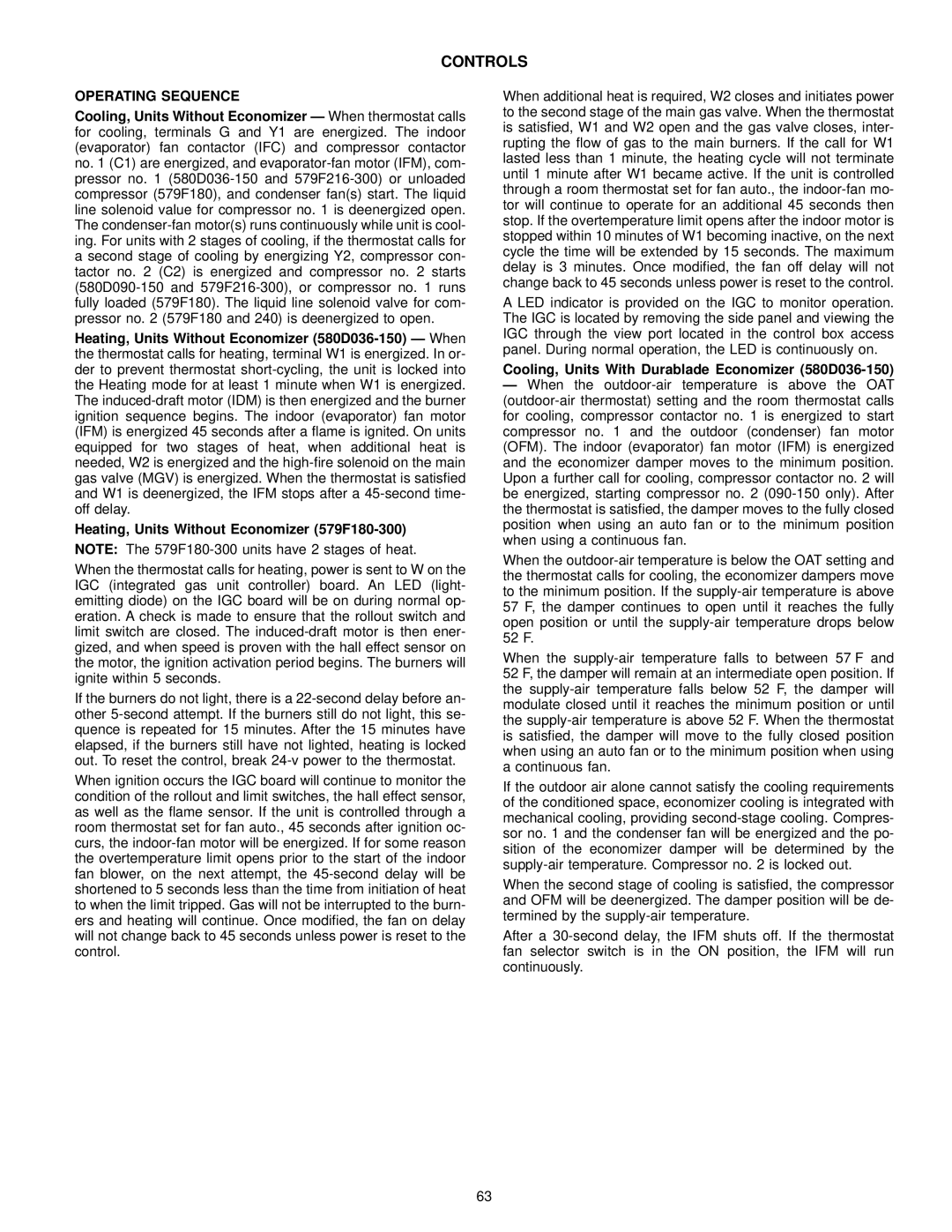580D036-072 579F180,216 580D090-150 579F240,300
FEATURES/BENEFITS
Page
Table of Contents
580D036-150 Models only
Model Number Nomenclature
Model Number Nomenclature 579F180-300 Models only
ARI* Capacity Ratings
Rise Efficiency
ARI* Capacity Ratings
Heating Capacities and Efficiencies Ð 580D036-150
Heating Capacities and Efficiencies Ð 579F180-300
Unit Size 580D
Physical Data Ð 580D036-072
Unit Size 580D Medium LOW/MEDIUM High Heat
Physical Data Ð 580D036-072
Pulley Center Line Distance Std
Physical Data Ð 580D090-150
090 102 120 150 Nominal Capacity tons
Quantity...Diameter Motor Hp...Rpm
Unit Size 580D LOW/MEDIUM High Heat Hihg Heat Medium Heat
Physical Data Ð 580D090-150
Unit Size 579F
Physical Data Ð 579F180-300
Physical Data Ð 579F180-300
Unit Size 579F
LOW/HIGH Heat
Head Pressure Control Speed Control 180,216
Options and Accessories
Option ACCESSORY²
Head Pressure Control
Sizes
Options and Accessories
Time Guard II Control
Durablade Economizer
Thermostat
Power Exhaust 180-300 Shown Accusensor Sensor
Accusensor Control
Only
Unit
Base Unit Dimensions Ð 580D036-072
Unit Corner Weight Dimensions
Base Unit Dimensions Ð 580D090-150
486 220 636 288
Base Unit Dimensions Ð 579F180,216
Dimension
Base Unit Dimensions Ð 579F240,300
Roof Curb Ð 580D036-072
Accessory Dimensions
Roof Curb Ð 580D090-150
Accessory Dimensions
579F
Dimensions degrees and inches
PKG. NO. REF Curb Description Height
Unit DEG
Pre-Assembled, High Static
Horizontal Supply/Return Adapter Installation 579F180-300
Power Exhaust 579F180-300
Accessory Curb Description Package no Height
II Select Unit Based on Required Cooling Capacity
Selection Procedure with 579F180 example
SHC
Performance Data Cooling Capacities
Cooling Capacities
Performance Data
Performance Data Cooling Capacities
580D120 10 Tons
580D150 121¤2 Tons
5400/0.06 6000/0.07 7200/0.08 9000/0.09
579F180 15 Tons Temp F Air Entering Evaporator Ð Cfm/BF
4500/0.08 5250/0.10 6000/0.11 6750/0.12 7500/0.14 Condenser
579F216 18 Tons
579F240 20 Tons Temp F Air Entering Evaporator Ð Cfm/BF
579F300 25 Tons
7000/0.03 8750/0.05 10,000/0.07 11,250/0.09
580D036 3 Tons Ð Alternate Motor Belt Drive
FAN Performance Ð 580D036-150 Vertical Discharge Units
580D036 3 Tons Ð Standard Motor Direct Drive
Fiop
580D048 4 Tons Ð Alternate Motor Belt Drive
580D048 4 Tons Ð Standard Motor Direct Drive
580D060 5 Tons Ð Alternate Motor Belt Drive
580D060 5 Tons Ð Standard Motor Direct Drive
1562
580D072 6 Tons Air¯ow External Static Pressure in. wg
Rpm Bhp Watts 1800
2600
3100
580D090 71¤2 Tons Air¯ow External Static Pressure in. wg
Rpm Bhp Watts 2250
2550
904 2300 3400
580D102 81¤2 Tons Air¯ow External Static Pressure in. wg
Rpm Bhp Watts 2550
891 2188 3300
985
580D120 10 Tons Air¯ow External Static Pressure in. wg
Rpm Bhp Watts 3000
4300
5200
580D150 121¤2 Tons Air¯ow External Static Pressure in. wg
Rpm Bhp Watts 3750
5100
FAN Performance Ð 580D036-150 Horizontal Discharge Units
352 788 410 887 546 928 615 968 683 1400 640 284 705
1989 1466 2171 Bhp Brake Horsepower Input to Fan
Rpm Bhp Watts 1200 569 189 641
299 761 357 859 483 901 546 943 609 1300 604 231 673
1331 1986 1400 2227 1461
Medium Speed High Speed 208 230, 460, 575 230,460, 575
1392
1365 2038 1426
1603
1536
1514
1496 2240 1529
895
997 3055 1040 3333 Bhp Brake Horsepower Input to Fan
894
882
812
1062 3676 1102 3860 Bhp Brake Horsepower Input to Fan
Rpm Bhp Watts 2550 669 627 867 692 1056 754
783
1019
962
1008
973
1131
Bhp Watts 3750
1166
1178
FAN Performance Ð 579F180-300 Units
Performance Data FAN Performance Ð 579F180-300 Units
9500
10,000 Bhp Brake Horsepower Input to Fan
579F240 20 Tons Air¯ow External Static Pressure in. wg
Rpm Bhp Watts 6000
3507
10,500 11,000 11,250 Bhp Brake Horsepower Input to Fan
579F300 25 Tons Air¯ow
Rpm Bhp Watts 500
Unit Minimum CFM Maximum CFM
Sound Power Total Unit
Sound Weighted Octave Bands Unit Rating
AIR Quantity Limits
Unit Motor Pulley Turns Open
ACCESSORY/FIOP Static PRESSURE* in. wg − 580D090-150
ACCESSORY/FIOP Static PRESSURE* in. wg − 579F180-300
Component CFM
Input
Altitude COMPENSATION* Ð
Btuh Nominal
Nominal Input
Altitude Derating FACTOR* Ð ALL Units
Fan Performance Using Accessory Power Exhaust 579F180-300
Altitude COMPENSATION* Ð 580D090-150
EVAPORATOR-FAN Motor Efficiency
580D036
EVAPORATOR-FAN Motor Performance
Maximum Unit EVAPORATOR-FAN Acceptable
Continuous Operating AMP Draw BHP
RLA LRA FLA MCA MOCP²
Electrical Data Ð 580D036-150
Electrical Data Ð 579F180-300
NEC Ð National Electrical Code
Typical Piping and Wiring Ð 580D036-150
Vertical Discharge Ducting
Horizontal Discharge Ducting
579F180 shown
Typical Piping and Wiring Ð 579F180-300
Typical Wiring Schematic Ð 580D036-150
Typical Wiring Schematic 579F240-300, 460-v shown
IFC
AHA
PRI
IDM
Operating Sequence
Controls
Cooling, Units With Parablade Economizer 580D036-072
Controls
580D036-150
Application Data
Application Data
Part 1 Ð General
Guide Specifications Ð 580D036-150
Guide Specifications Ð 580D036-150
Guide Specifications Ð 580D036-150
Guide Specifications Ð 579F180-300
Guide Specifications Ð 579F180-300
Copyright 1998 Bryant Heating & Cooling Systems
